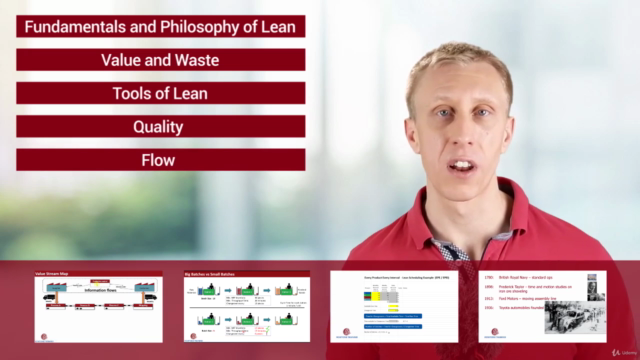Lean Manufacturing A-Z: Operations Management & Six Sigma

Why take this course?
It looks like you've outlined a comprehensive curriculum on Lean management principles, which includes an exploration of the history, tools, and methodologies that are fundamental to Lean practices, as well as a comparison with Six Sigma. This curriculum is designed to provide a deep understanding of Lean thinking and how it can be applied to improve processes, reduce waste, and enhance customer value.
Here's a brief overview of the topics you've outlined:
-
Introduction to Value Stream Mapping: This is where you start by understanding what Value Stream Mapping (VSM) is and how it helps visualize the flow of materials and information as a product moves through the value stream.
-
The 7 Wastes: Lean thinking identifies seven types of waste that must be minimized or eliminated to improve efficiency and value delivery. These wastes are Defects, Overproduction, Waiting, Non-utilized talent, Transportation, Inventory, and Extra-processing (TIMWOOD).
-
Inventory Management: This topic covers the role of inventory in a Lean system, including why it's necessary and the costs associated with maintaining inventory. It also introduces tools like Little's Law to understand how inventory levels relate to flow and customer service.
-
Tools of Lean: This section dives into the various tools used in Lean, such as 5S, SMED, Value Stream Mapping (VSM), Visual Management, Gemba Walks, Standard Work, PDCA Improvement Cycle, A3 Reports, and more.
-
Quality: Quality is a central component of Lean, focusing on reducing complexity, mistakes, and variation to ensure high-quality products and services are delivered consistently. It covers techniques like Jidoka (autonomation), Poka-Yoke (mistake proofing), Root Cause Analysis, and Total Productive Maintenance (TPM).
-
Flow: Flow focuses on creating smooth, continuous processes to improve efficiency and reduce lead times. It covers the concepts of Takt Time, Cycle Time, Batch Sizes, and the importance of one-piece flow.
-
History of Lean: This topic provides an overview of the history and development of Lean principles, with a focus on the Toyota Production System as the foundation for many Lean practices.
-
Six Sigma: Six Sigma is a methodology that aims to improve the quality of process outputs by identifying and removing the causes of defects and variability in processes. This section covers the principles, history, and tools of Six Sigma, including DMAIC, and compares Lean and Six Sigma.
Each of these topics is critical for understanding how to implement Lean principles effectively and for comparing them with the methodologies of Six Sigma. Together, they provide a comprehensive framework for continuous improvement in any process-driven organization.
Course Gallery




Loading charts...
Comidoc Review
Our Verdict
Excelling in both breadth and engagement, the "Lean Manufacturing A-Z: Operations Management & Six Sigma" course on Udemy provides a thorough grounding in Lean principles, Six Sigma fundamentals, and process improvement techniques. Despite minor flaws like misplaced quiz questions and occasional shallow coverage of specific topics, this course is highly recommended for both beginners and advanced learners looking to enhance their understanding of Lean methodologies.
What We Liked
- Instructor's dynamic presentation style and clear visualizations make complex concepts easy to understand
- Comprehensive course structure with real-life examples and charismatic delivery helps in engaging learners
- Course covers Lean Manufacturing, Six Sigma, operations management, and process improvement techniques
- Well-paced modules with tests complement understanding, enabling learners to resolve doubts
Potential Drawbacks
- Lacks depth in certain areas like protocols for illustrating concepts, history of Lean and 6 Sigma
- Quiz questions could be more contextual and less reliant on extraneous knowledge
- Tests are placed within modules instead of after learning sections, which might affect comprehension
- Some learners might desire further elaboration and examples for practical use in the industry